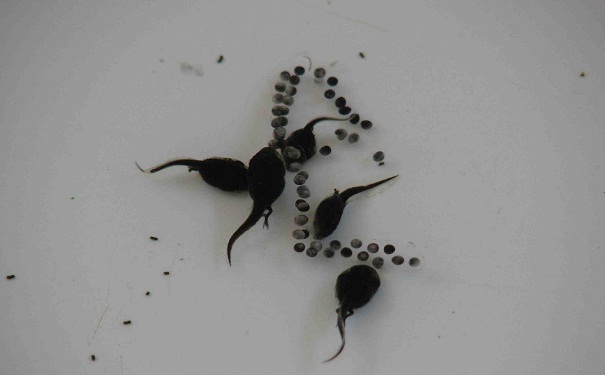
Cane toad tadpoles eat toad eggs to remove future competition. Image: Mattias Hagman
The chemicals released by cane toads could be used to impede their invasion.
Cane toads are regarded as the worst invasive species in Australia and they have very few predators. However, they are their own worst enemies, as they compete with each other, eat each other and even use chemical weapons to remove the competition.
Scientists from the University of Sydney have discovered that cane toads communicate via waterborne chemicals. One of these chemicals is an alarm pheromone that causes other toad tadpoles to flee; the other attracts them to new competition.
“In the case of the alarm pheromone, the toad tadpoles use the chemical to alert them to the fact that a nearby toad tadpole has been attacked or stressed, so there is something to worry about – and the best response may be to get the hell out of there,” said Professor Rick Shine
If the tadpoles are exposed to the alarm pheromone too often, they can die from stress. And even if they manage to survive frequent exposure, they will grow to become stunted toadlets with lower chances of survival.
Professor Shine said the researchers are still uncertain as to the source of the chemicals. “Toad tadpoles have specialised secretory cells in their skin, and these are the likely source of the chemicals. But we really don’t know.”
The second chemical is released by the freshly laid eggs and attracts cane toad tadpole. This chemical allows them to seek out and kill any future competitors.
“The attractant is likely just a by-product of egg development -what has evolved in this case is the ability of older (cannibal) tadpoles to detect that chemical at very low concentrations, and zero in on it to find the newly-laid eggs,” said Professor Shine.
The idea behind this research is to take the cane toads’ chemical weapons and use it against them. “If we (can) identify the chemicals involved, we can affect toad tadpoles without influencing the tadpoles of native frogs, because the toad’s chemical “language” is detected only by other toads,” said Professor Shine.
“For example, the chemical that older tadpoles use to disrupt the development of younger toad tadpoles could be added to spawning ponds, and would kill many of the younger toad tadpoles before they could develop. Similarly, we could use the attractant chemical in traps, to catch toad tadpoles but not native species.”






